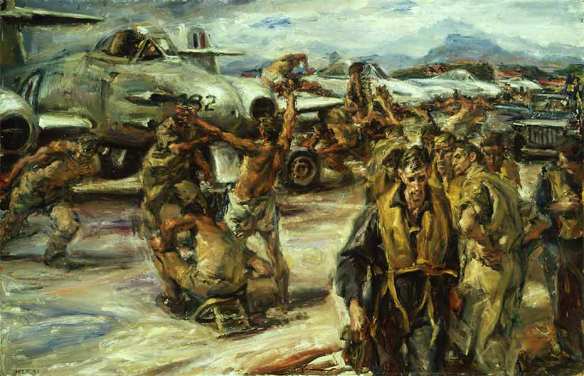Warrant Officer Ron Guthrie.
Return of the Meteor jets, Kimpo, Korea. Oil on hardboard, 1953 by Ivor Hele. 77 Squadron, Royal Australian Air Force flew Meteors in Korea in 1952 and 1953. [AWM ART40304]
With air combats developing at altitudes of over 30,000 feet, it was inevitable that the Korean War should see new records set for high-altitude parachute escapes. An air battle fought on 29 August, 1951, between Gloster Meteor Mk 8s of No 77 Squadron, Royal Australian Air Force, and Chinese MiG-15s saw the highest recorded baleout to date. On this day, eight Meteors were detailed to escort B-29s and another eight to carry out a diversionary sweep north of Sinanju. At 11.20 the latter flight, led by Squadron Leader Wilson, spotted six MiGs at 40,000 feet over Chongju, 5,000 feet higher than themselves. Keeping the enemy in sight Wilson manoeuvred his formation up-sun, but as he did so two more MiGs appeared a few thousand feet below. Wilson decided to attack and went into a dive followed by his number two, Flying Officer Woodroffe. As the two Meteors levelled out, however, Woodroffe’s aircraft suddenly flicked into a spin (an unpleasant tendency of the Meteor 8, caused by the effects of compressibility, if the aircraft exceeded 0.8M at altitude) and dropped away; the pilot managed to recover several thousand feet lower down, but now Wilson had no one to cover his tail. As he began his approach to attack, a MiG jumped him out of the sun, unnoticed in the 30-degree blind spot caused by the dural structure at the rear of the Meteor’s cockpit. The first warning Wilson had of the danger was when cannon shells passed over his wing; he immediately put his aircraft into a maximum-rate turn in a bid to shake off his pursuer. He was rescued by Flight Lieutenant Cedric Wilson and Flying Officer Ken Blight, who spotted his predicament and drove the MiG away – but not before cannon shells had shot away Sqn Ldr Wilson’s port aileron and punched a three-foot hole in his port wing, puncturing a fuel tank. Despite the damage Wilson reached base safely, touching down at 30 knots above normal landing speed.
Meanwhile, a fierce air battle had developed over Chongju as the other Meteors were hotly engaged by thirty MiGs. The weight of the attack fell on ‘Dog’ section, led by Flt Lt Geoff Thornton, who saw the MiGs coming down and ordered his section to break as soon as the enemy opened fire. Flying in the number four position was Warrant Officer Ron Guthrie, a veteran of fourteen previous Meteor sorties over Korea, and as he broke hard to port his aircraft was hit by cannon shells aft of the cockpit, destroying his radio equipment. Two of Guthrie’s attackers passed in front of him and he got one in his sights, loosing off a burst of 20mm cannon fire, but before he had time to observe any result he came under attack again, and this time the Meteor went out of control.
As the Meteor passed through 38,000 feet in a rolling dive, with the Machmeter showing 0.84, Guthrie ejected. The Martin-Baker seat worked perfectly and Guthrie sat upright in it as it descended through the stratosphere. It was like sitting in an armchair, with the world unfolding at his feet, and the situation might almost have been pleasant had it not been for the fact that he was falling into enemy territory and that his oxygen mask had been ripped away on ejection. Fortunately, it was still attached to the emergency supply and he managed to get it back on, finding to his relief that the oxygen was still flowing.
Guthrie now had a decision to make. The air temperature at that altitude was minus 50 degrees C and he was wearing only a lightweight summer flying suit. If he jettisoned his seat and opened his canopy at this stage, there was would be a very real danger of frostbite. On the other hand, altitude would give him an advantage: he might be able to steer his parachute clear of the North Korean coastline and make a touchdown in the sea, where he would have a good chance of being picked up by friendly forces. He decided to take the risk. Unfastening his harness, he kicked the seat away and pulled the ripcord.
His parachute opened at 35,000 feet. From that height he could see the curvature of the earth, and the whole panorama of the Korean peninsula spread out below him. The air grew warmer as he continued his descent, but now he realised with dismay that a westerly wind was blowing him inland, and that despite his best efforts to control the direction of his parachute he was not going to reach the coast. Twenty-eight minutes after ejecting, having survived the attentions of some enemy troops who fired at him in the latter stages of his descent, he landed in a paddy field and was quickly surrounded. It was the beginning of a two-year captivity. At that time, Guthrie’s was the highest ejection on record. He had also experienced the longest parachute descent, and it was the first time that a Martin-Baker seat had saved a pilot’s life in combat.
It was soon apparent that the Meteor was no match for the MiG-15, and it was soon reassigned to the ground attack role, which it performed well, leaving the F-86 Sabres to tangle with the MiGs in the stratosphere. Ground attack work in Korea was difficult and dangerous; quite apart from the nature of the terrain, targets were usually well defended. If an aircraft was hit, the pilot had two choices: either he could bale out into enemy hands, or he could try to gain sufficient height to nurse his crippled aircraft back to friendly territory,where he could either bale out or attempt a crash landing.
